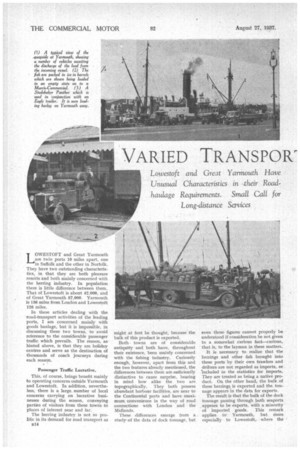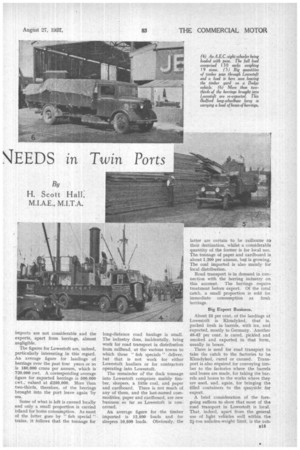VARIED IRAN SPOW
Page 48

Page 49

Page 50

If you've noticed an error in this article please click here to report it so we can fix it.
i-EEDS in Twin Ports
By
H. Scott Hall, M.I.A.E., M.I.T.A.
LOWESTOFT and Great Yarmouth are twin ports 10 miles apart, one in Suffolk and the other in Norfolk. They have two outstanding characteristics, in that they are both pleasure resorts and both mainly concerned with the herring industry. In population there is little difference between them. That of Lowestoft is about 42,000, and of Great Yarmouth 57,000. Yarmouth is 136 miles from London and Lowestoft 126 miles.
In these articles dealing with the Toad-transport activities of the leading ports, I am concerned mainly with goods haulage, but it is impossible, in discussing these two towns, to avoid reference to the considerable passenger traffic which prevails. The reason, as hinted above, is that they are holiday centres and serve as the destination of thousands of coach journeys during each season.
Passenger Traffic Lucrative.
This, of course, brings benefit mainly to operating concerns outside Yarmouth and Lowestoft. In addition, nevertheless, there is a large number of local concerns carrying on lucrative businesses during the season, conveying parties of visitors from these towns to places of interest near and far, The herring industry is not so prolific in its demand for road transport as n14 might at first be thought, because the bulk of this product is exported.
Bothtowns are of considerable antiquity and both have, throughout their existence, been mainly concerned with the fishing industry. Curiously enough, however, apart from this and the two features already mentioned, the differences between them are sufficiently distinctive to cause surprise, bearing in mind how alike the two are topographically. They both possess abundant harbour facilities, arc near to the Continental ports and have maximum convenience in the way of road connections with London and the Midlands.
These differences emerge from a study of the data of dock tonnage, but even those figures cannot properly be understood if consideration be not given to a somewhat curious fact---curious, that is, to the layman in these matters.
It is necessary to realize that the herrings and other fish brought into these ports by their own trawlers and drifters are not regarded as imports, or. 'Included in the statistics for imports. They are treated as being a native product. On the other hand, the bulk, of these herrings is exported and the tonnage appears in the data for exports. The result is that the bulk of the dock tonnage passing through both seaports appears to be exports, with a minority of imported goods. This remark applies to Yarmouth, but more especially to Lowestoft, where the imports are not considerable and the exports, apart from herrings, almost negligible.
The figures for Lowestoft are, indeed, particularly interesting in this regard. An average figure for landings of herrings over the past four years or so is 180,000 crans per annum, which is 720,000 cwt. A corresponding average figure for exported herrings is 500,000 Cwt., valued at £250,000. More than two-thirds, therefore, of the herrings brought into the port leave again by sea.
Some of what is left is canned locally and only a small proportion is carried inland for home consumption. As most of the latter goes by " fish special " trains, it follows that the tonnage for long-distance road haulage is small. The industry does, incidentally, bring work for road transport in distribution from railhead, at the various towns to which these " fish specials " deliver, but that is not work for either Lowestoft hauliers or for contractors operating into Lowestoft.
The remainder of the dock tonnage into Lowestoft comprises mainly timber, sleepers, a little coal, and paper and cardboard. There is not much of any of them, and the last-named commodities, paper and cardboard, are new business so far as Lowestoft is concerned.
An average figure for the timber imported is 12,500 loads and for sleepers 10,500 loads, Obviously, the latter are certain to be railborne to their destination, whilst a considerable quantity of the former is for local use. The tonnage of paper and cardboard is about 1,200 per annum, but is growing_ The coal imported is also mainly for local distribution.
Road transport is in demand in connection with the herring industry on this account. The herrings require treatment before export. Of the total catch, a small proportion is sold for immediate consumption as fresh herrings.
Big Export Business.
About 25 per cent. of the landings at Lowestoft is Klondyked, that is, packed fresh in barrels, with ice, and exported, mostly to Germany. Another 40-42 per cent, is cured, pickled and smoked and exported in that form, usually in boxes.
There is need for road transport to take the catch to the factories to be Klondyked, cured or canned. Transport is also required for conveying timber to the factories where the barrels and boxes are made, for taking the barrels and boxes to the works where they are used, and, again, for bringing the filled containers to the quayside for export.
A brief consideration of the foregoing suffices to show that most of the road transport in Lowestoft is local. That, indeed, apart from the general use of light vehicles well within the 2i-ton unladen-weight limit, is the out. standing characteristic of all branches of road-transport operation in that seaport.
Mr. R. Ayers is one of the principal fish merchants in Lowestoft, and he finds two light-type vehicles—they are actually Chevrolets—sufficient for his transport. Mr. Ayers confirmed the paucity of need for long-distance road transport, although there are one or two firms who haul direct to London and Liverpool.
Special Body Designs.
In conversation with Mr. Ayers, an interesting point emerged relating to the design of the bodywork of vehicles for fish transport. As the outcome of his own personal experience, he has put a layer of zinc between the upper and lower floors of both his vehicles, with the object of preventing water from draining on to parts of the chassis.
Mr. Craske, a leading coal importer, told me that most of the coal which leaves the port for inland destinations goes by barge. He, too, uses lightweight motor vehicles for local distribution, and has, in fact been operatingMorris-Commercials for this purpose since 1924.
Turning now to consider Great Yarmouth, here the total tonnage is much greater than at Lowestoft and there is a bigger proportion of imports, of which timber is, nevertheless, the outstanding product. Typical figures for the annual import of this commodity are 110,000 loads valued at £400,000.
Mixed Cargoes at Yarmouth.
There is a fair proportion of grain— mainly maize, but including also wheat and barley—to the extent of 350,000 cwt., valued at £85,000. Feeding stuffs for animals—principally cereals and including dried peas—total 7,000 tons, valued at £30,000, and oil cake, 2,000 tons at £10,500. Paper and cardboard, too, are coining to Yarmouth, a recent figure being 80,000 cwt. in a year, the value of these goods amounting to £33,000.
The figure for herrings exported is double that of Lowestoft, being 1,000,000 cwt. valued at 4500,000. Grain and flour to the extent of 21,000 cwt. are exported, their value being £15,000, and molasses, 200,000 cwt. at £20,000.
e16 So far as the herring industry is concerned, what has been stated concerning road transport in this connection at Lowestoft applies with equal force in respect of Yarmouth. There is some slight difference in practice, as only a small proportion of the catch at Yarmouth (about 5 per cent.) is Klonclyked, but as much as 65 per cent. is cured. In passing, it is of interest to note that the method of curing varies according to the destination for which the fish is bounck Italian importers prefer their herrings to be pale in colour, to which end they are pickled for eight days and smoked for a night. Other countries like them darker. These are pickled for five days and then smoked for five days. Some proportion of the catch is also salted into boxes.
Road transport in Yarmouth, and, perhaps, to a lesser extent in Lowestoft, has a competitor additional to the railways. There is an active water-transport industry in these towns and considerable use is made of the Broads and rivers for haulage, particularly of timber, inland.
Nevertheless, there is considerable use made of road vehicles, and one of the accompanying illustrations, besides being typical, serves to show how active load carriers are in Great Yarmouth. So soon as a cargo boat docks, the whole of the quay alongside the vessel is immediately crowded with motor • vehicles, a surprising variety of types and sizes being represented. This is particularly the case when the materials comprise cereals, cattle foods, dried peas, oil cake and the like. The timber is usually unloaded from vessels direct into wharves_ One leading concern in Great Yarmouth, jewson's, has wharves lining the river for some distance and the stocks of timber to be seen are huge.
Locally Built Tractors Do Good Work.
For the long-distance transport of timber by road, practically every size of vehicle is employed. For local delivery a particular type of vehicle is especially favoured. It is a tractor made by Messrs. A. Webber, Cobholin Island, Great Yarmouth, from Fordsori and Ford parts.
These tractors are used generally to haul trailers empty and loaded from point to point, from timber wharves to factories where boxes are made and to railway stations, but they are designed so that they can, if necessary, be used for shunting. I observed these machines in widespread employment not only at Great Yarmouth, but also at Lowestoft and /pewich.
The same characteristic obstructionist policy as I have observed in some other seaports is followed by the railway companies in both these towns. As part of the routine business of collecting information for this article, I called, as a matter of course, on the harbour masters of Lowestoft and Yarmouth. Neither was prepared to give me any assistance whatever, nor to enter into any useful discussion.
Railways Fear Road Transport.
This attitude seems to emphasize the fact that The railway companies go in deadly fear of road transport—so much so that they prefer not to allow their servants to extend, on their own responsibility, those courtesies which journalists are accustomed to meeting all the world over, in connection with whatever inquiries they may be called upon to make.
My reception at these two ports vvas in striking contrast to that of Ipswich, visited during the same tour. There I met with every courtesy and was given all possible assistance at the hands of the harbour master. The harbour at Ipswich, you see, is under the control of a public body, the Docks Commission.




















































































